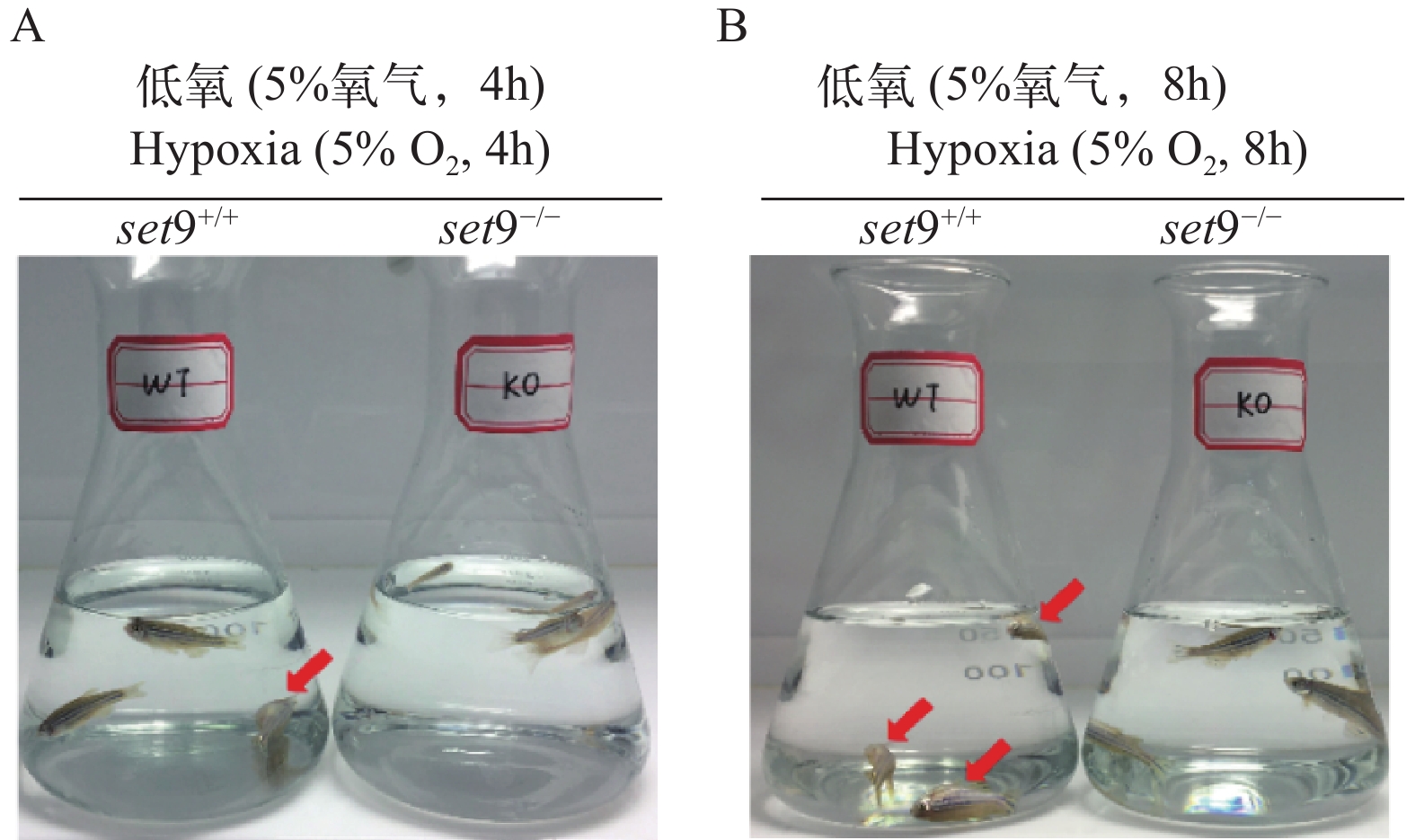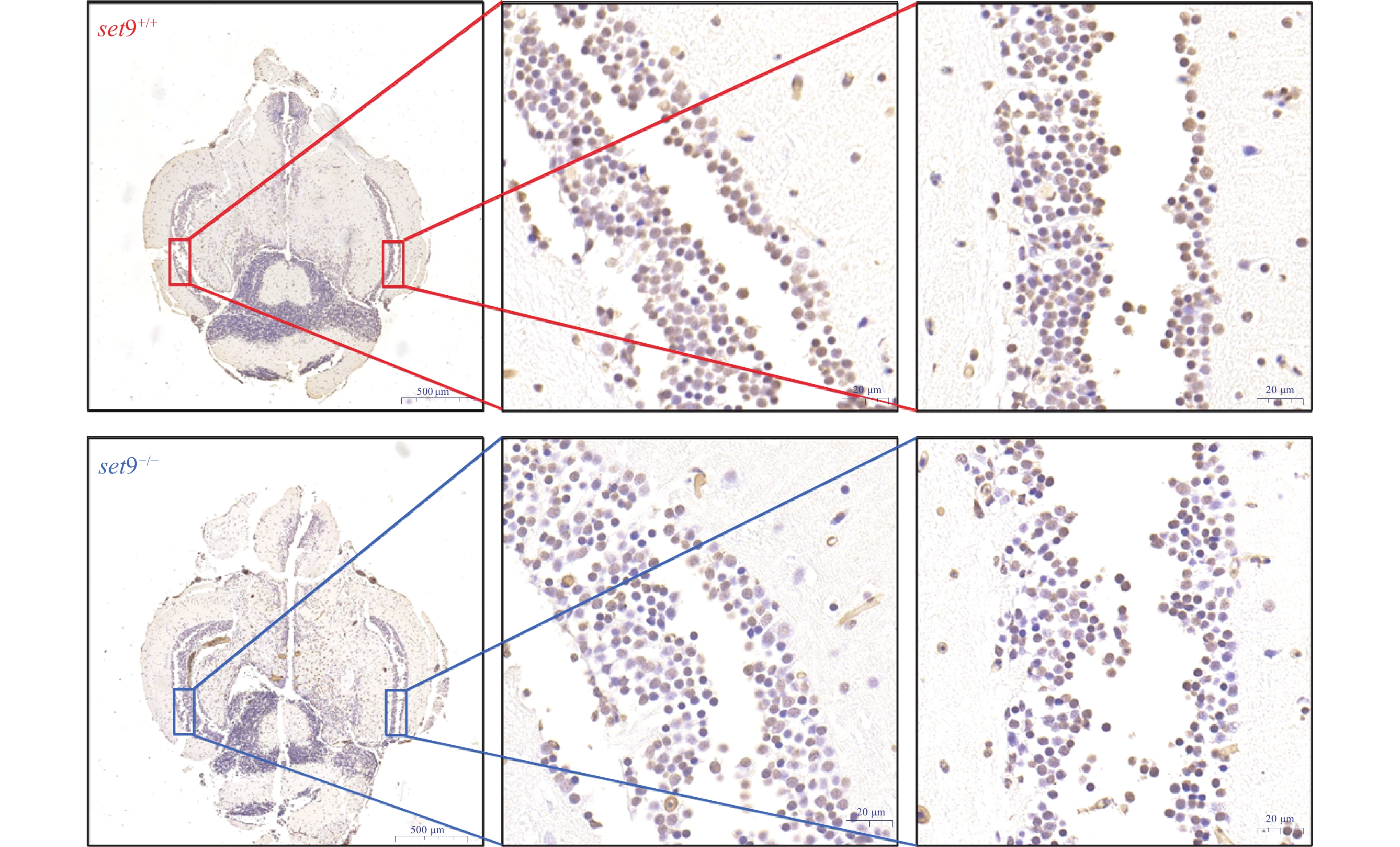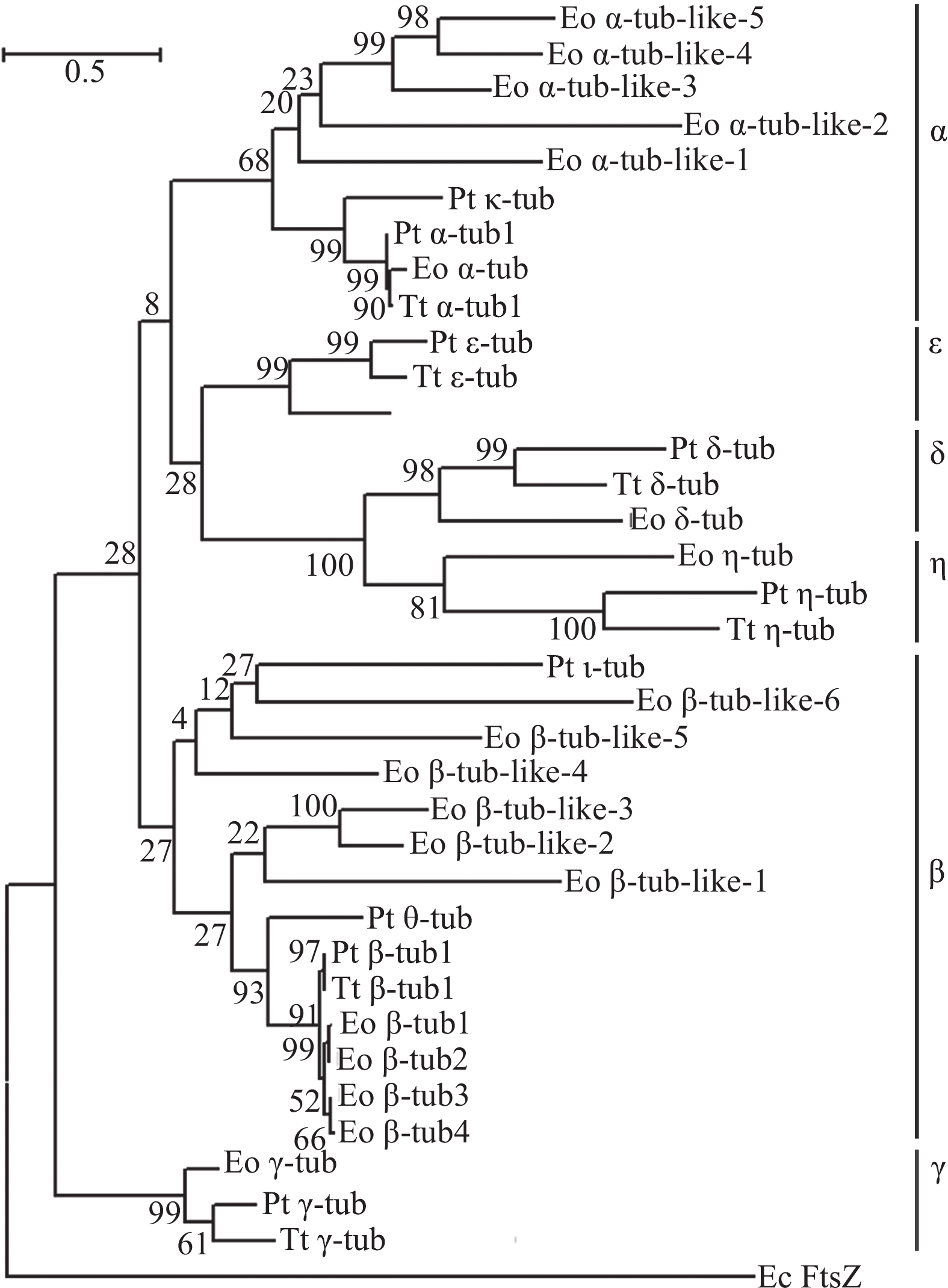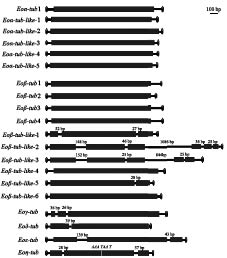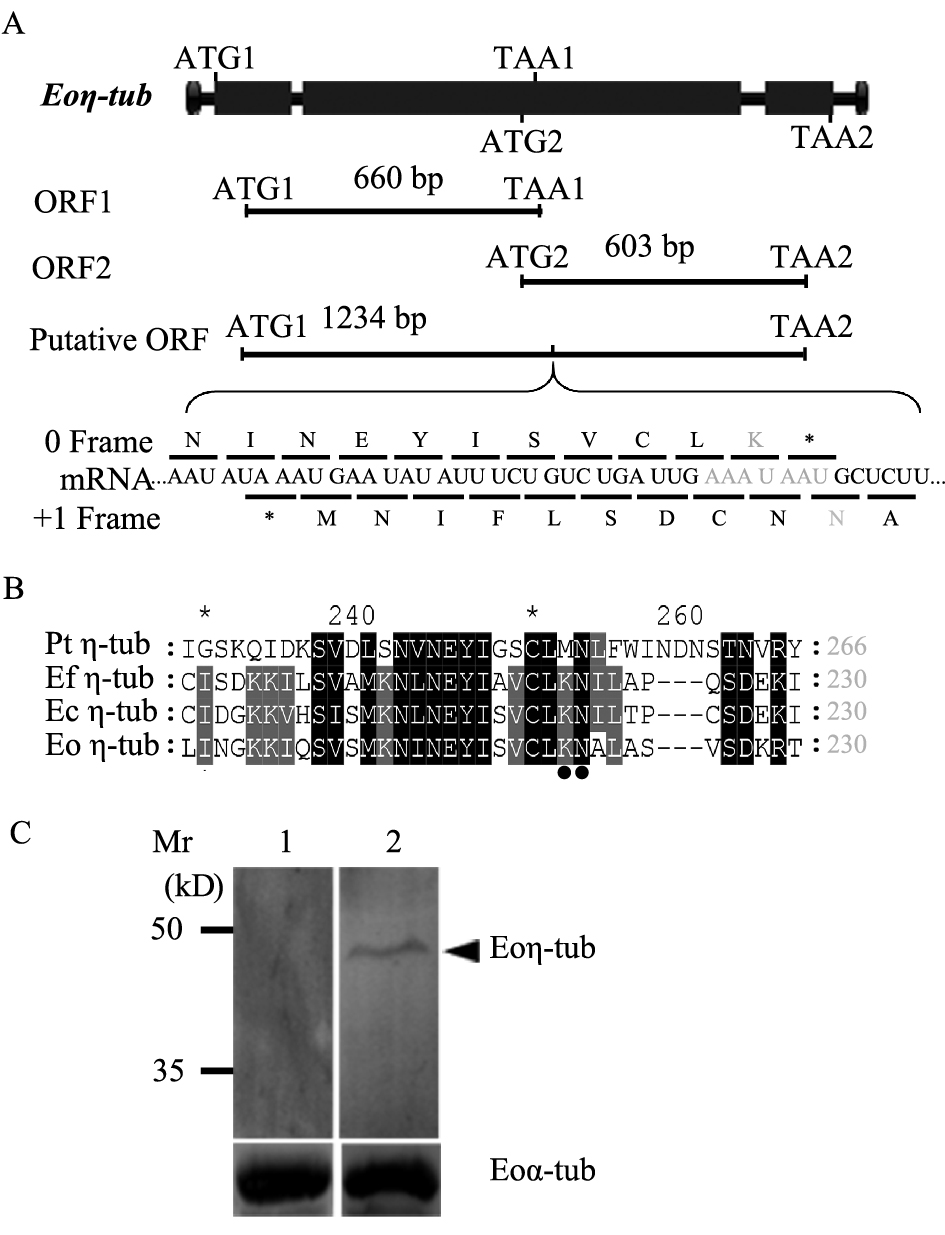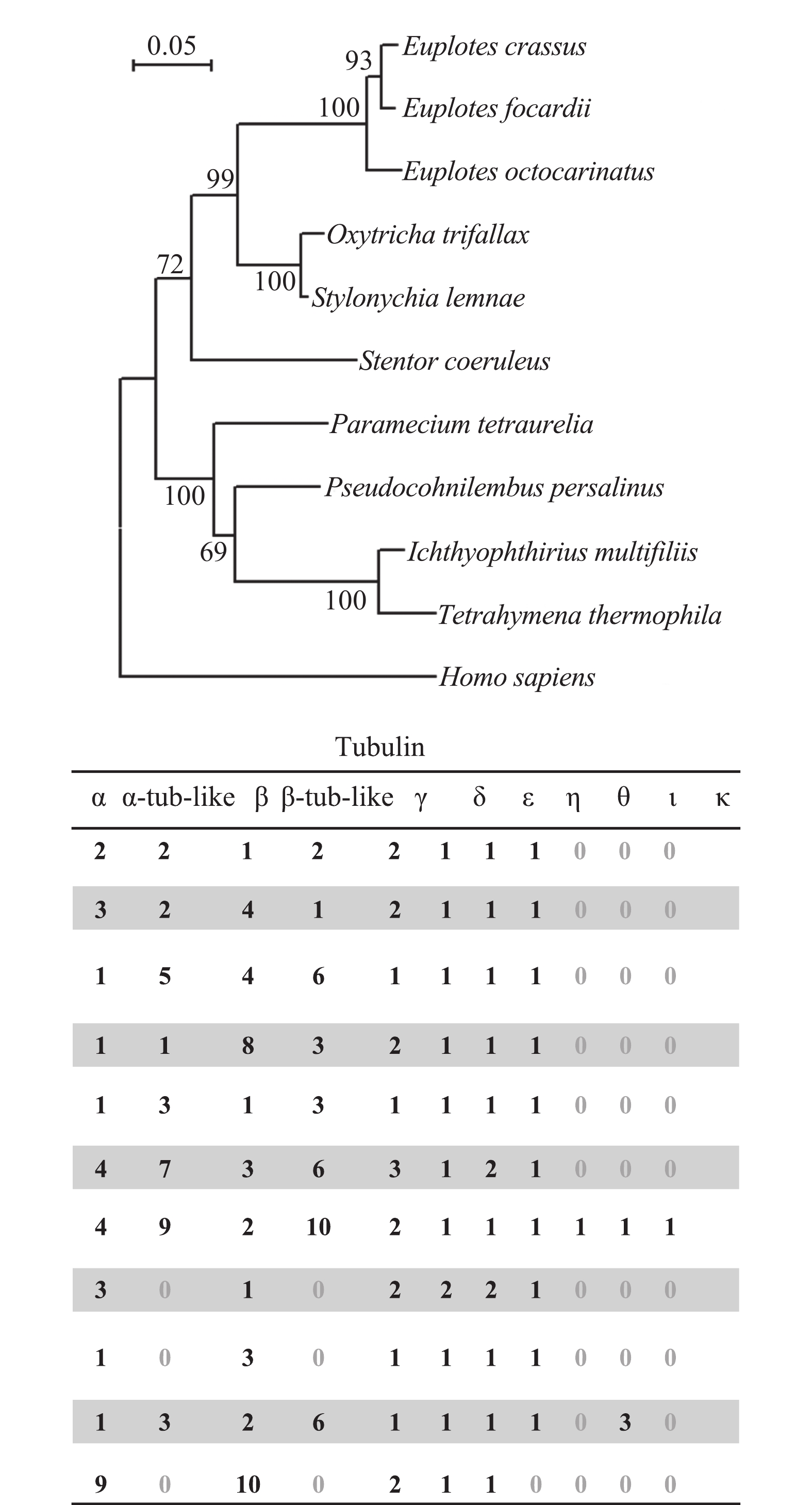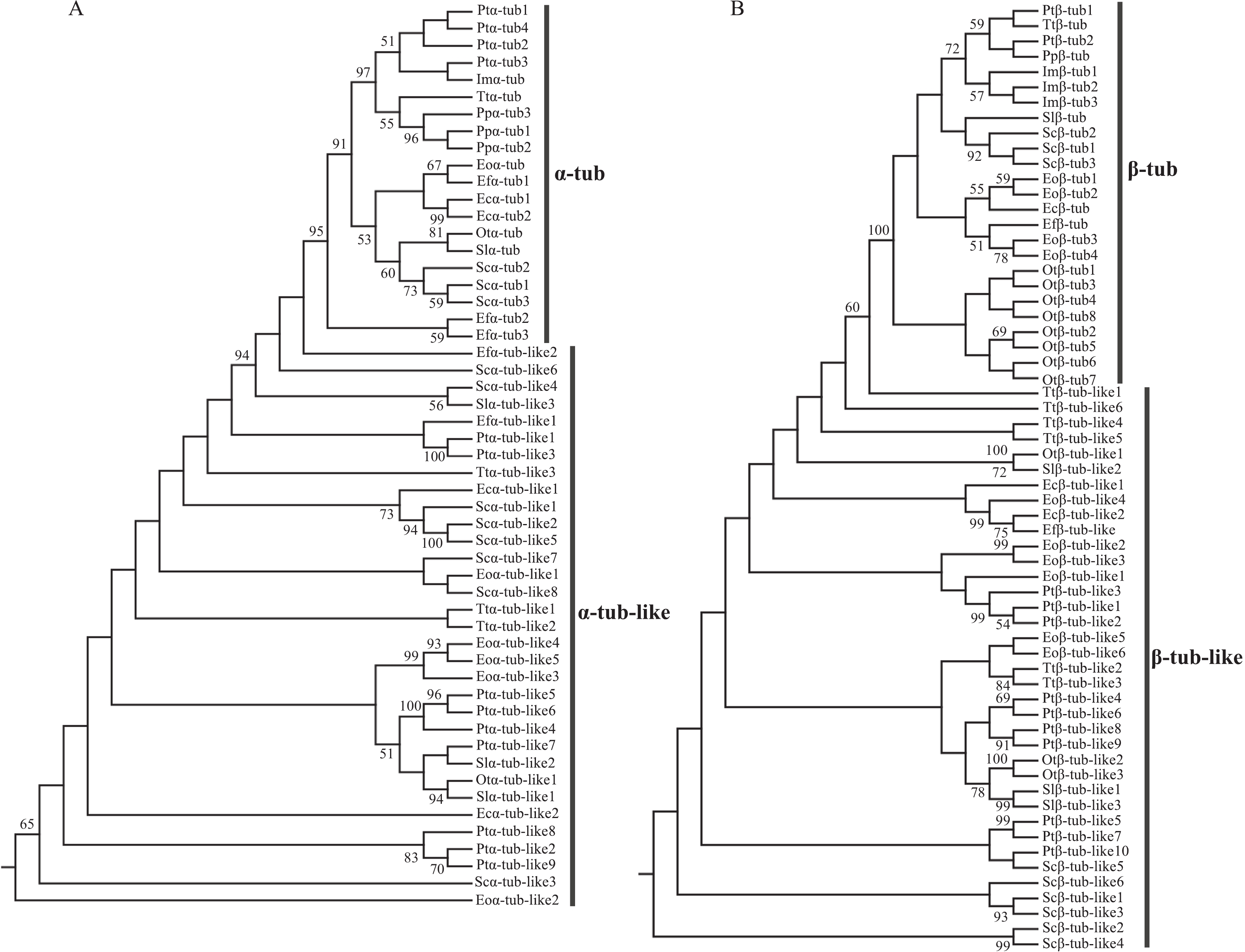IDENTIFICATION AND EVOLUTION ANALYSIS OF TUBULIN SUPERFAMILY GENES IN EUPLOTES OCTOCARINATUS
-
摘要: 为了系统分析八肋游仆虫(Euplotes octocarinatus)微管蛋白基因家族, 从八肋游仆虫大核基因组中共鉴定得到20个微管蛋白基因, 基于同源比对及系统进化分析, 将其归入α、β、γ、δ、ε及η六个微管蛋白亚家族; 多序列比对及Western blot结果显示八肋游仆虫η微管蛋白基因在翻译过程中需发生一次+1位编程性核糖体移码, 其移码位点为AAA-TAA; 所有自由生纤毛虫都含有多个α和β微管蛋白基因亚型, 可能用于组成不同的微管结构。研究为后续深入探讨八肋游仆虫微管蛋白的生物学功能及微管多样性奠定了基础。Abstract: Microtubules represent one of the major cytoskeletal filament systems of all eukaryotic cells. They play a key role in spatial arrangement of the organelles, intracellular transport, nuclear and cell division, and ciliar motility. Ciliates are ideal model organisms for studying the functional diversity of tubulins. Here, a total of 20 tubulin genes were identified in the macronuclear genome of the ciliate Euplotes octocarinatus. Based on ortholog comparisons and phylogenetic analysis, these genes were clustered into six groups: α-, β-, γ-, δ-, ε- and η-tubulins. Sequence analysis and western blots suggested that the η-tubulin gene of E. octocarinatus required a +1 programmed ribosomal frameshifting to produce complete protein product. The slippery sequence is AAATAAT. We further systematically identified tubulin genes from 9 other ciliates and compared them with E. octocarinatus. The α- and β-tubulins of all investigated free-living ciliates are encoded by multigene families, and each tubulin isotype may be used to form distinct tubulin structures. Phylogenetic analysis showed that α- and β-tubulin genes underwent multiple independent duplications and losses in ciliate. Our study lays a foundation for studying the biological function of tubulins and exploring the mechanisms of microtubule diversity.
-
Keywords:
- Euplotes octocarinatus /
- Tubulin /
- Sequence analysis /
- Phylogenetic analysis
-
低氧诱导因子(Hypoxia inducible factor, HIF)介导的转录激活调控是细胞感受氧气变化和应答低氧胁迫的最为关键的信号传导途径[1, 2]。低氧信号传导途径非常保守, 从线虫到人类, 低氧信号都启动相同或相似的同源基因的转录和调控, 从而调控类似的生理和生化反应[3]。HIF由HIF-α(包括HIF-1α和HIF-2α)和HIF-1β两个亚单位组成, 每个亚单位都包含基本的bHLH-PAS (helix-loop-helix-PAS)结构域, 该结构域介导异源二聚体的形成及与DNA的结合。HIF-1β的蛋白水平稳定, 因而HIF的活性主要由HIF-α来决定[4, 5]。在常氧条件下, HIF-α能够被一类依赖于氧气的脯氨酸羟化酶(Prolyl hydroxylase domain enzymes, PHDs, 包括PHD1, PHD2 和PHD3)所识别, 进而对HIF-α(包括HIF-1α和HIF-2α)上特定的脯氨酸残基进行羟基化修饰, 其中, PHD2是起主要作用的脯氨酸羟化酶[6]。被羟基化修饰的HIF-α能被pVHL(Von Hippel-Lindau)识别, pVHL能够与ElonginB、ElonginC结合形成E3泛素连接酶复合体, 介导HIF-α通过蛋白酶体降解[7]。在低氧条件下, 由于氧气的缺乏, 使得脯氨酸羟化酶的活性受到抑制, HIF-α的羟基化修饰受到抑制, 进而导致HIF-α的蛋白酶体降解途径受到抑制, 从而导致HIF-α的蛋白水平得以积累, 积累的HIF-α进入细胞核, 与HIF-1β形成异源二聚体, 该二聚体与下游基因启动子上的低氧应答元件(Hypoxia response element, HRE)结合, 从而激活下游基因的表达, 发挥相应的生物学功能[1, 4]。
蛋白质赖氨酸残基上的甲基化修饰主要是由一类含有SET 保守结构域的蛋白质完成的, 目前在哺乳动物中已鉴定到50多种蛋白质可以归入这一家族, 组蛋白甲基转移酶SET9就是该家族的成员[8, 9]。SET9可以甲基化修饰组蛋白H3上第4位的赖氨酸残基, 也可以对多种非组蛋白进行甲基化修饰[10-12]。SET9可以甲基化修饰p53上第372位的赖氨酸残基, 从而激活p53的转录活性[13]。SET9可以甲基化RelA第37位的赖氨酸残基, 在肿瘤坏死因子TNFα的刺激下增强RelA与下游基因启动子的结合[14]; SET9也可以甲基化RelA第314和315位的赖氨酸残基, 从而促进与下游基因启动子结合的RelA的降解, 抑制NF-κB信号通路的激活[15]。
前期的研究工作发现SET9可以甲基化HIF-1α上第32位的赖氨酸残基, 抑制HIF-1α与下游基因启动子的结合, 从而抑制低氧信号通路下游基因的表达[16]。但是, SET9在体内调控低氧信号通路和在低氧胁迫中的生物学功能及其机制还并不清楚。
研究基因在体生物学功能最好的手段是建立该基因敲除的动物模型。斑马鱼(Danio rerio)是重要的模式生物, 建立目的基因敲除的斑马鱼品系有助于研究该基因的在体生物学功能。前期的研究工作以斑马鱼为模式生物, 建立了foxo3b、tet1及fih敲除的斑马鱼品系, 用以研究这些基因在低氧耐受中的生物学功能。foxo3b可以诱导vhl的表达, 从而促进hif-α的降解, foxo3b的敲除会导致斑马鱼低氧耐受能力的下降[17]; tet1可以稳定hif-α的蛋白水平, tet1的敲除会降低斑马鱼的低氧耐受能力[18]; fih可以抑制hif-α的转录激活活性, fih的敲除可以增强斑马鱼的低氧耐受能力[19]。
本研究利用CRISPR/Cas9基因编辑技术, 获得了甲基转移酶set9敲除的斑马鱼品系, 初步分析了set9基因的敲除对斑马鱼低氧耐受能力的影响, 为研究鱼类甲基转移酶set9在低氧耐受中的生物学功能及耐低氧鱼类新品种的培育提供了理论依据。
1. 材料与方法
1.1 主要试剂及仪器
主要试剂 DNA胶回收试剂盒购自Bioflux公司, 质粒小提试剂盒购自天根公司, 限制性内切酶、RNAiso plus购自TaKaRa, All-in-One cDNA Synthesis SuperMix kit试剂盒、SYBR Green Fast quantitative PCR master mix试剂盒购自Biotool公司, T4 DNA连接酶、DNase Ⅰ购自Fermentas公司, T7体外转录试剂盒购自Ambion公司, Agarose、2×Sosoo Mix重组酶购自Tsingke公司, DNA Marker、Trans10感受态细胞购自TransGen公司, 多聚甲醛、DEPC购自Amresco公司。
主要仪器 显微注射仪PLI-100(Harvard Aparatus), 斑马鱼生化培养箱SHP-150(上海精宏), 低氧工作站Invivo2(Ruskinn), 凝胶成像系统(上海培清科技有限公司), 离心机5702、5430、5425D、5415R(Eppendorf), 荧光定量PCR仪Step One Real-Time PCR System(ABI), 恒温水浴锅(上海精宏), Nanodrop 2000浓度定量仪(Thermo), –80℃超低温冰箱(Thermo)。
1.2 斑马鱼品系
AB品系的斑马鱼购自国家斑马鱼资源中心。
1.3 序列分析
使用ClustalX2软件对人SET9、小鼠Set9和斑马鱼set9的氨基酸序列进行比对, 并根据已知的人SET9的结构域标注3个物种的SET结构域及其甲基转移酶的酶活性位点。
1.4 斑马鱼set9基因的敲除与鉴定
利用在线设计工具 (http://crispr.mit.edu) 设计Cas9作用的靶位点; 将体外合成的Cas9 mRNA和gRNA(guide RNA)按照400 ng/μL﹕60 ng/μL混合后, 注射到一细胞期胚胎动物极; 24h后, 利用异双链迁移率测定法(Heteroduplex mobility assay, HMA)筛选有敲除效果的F0代嵌合体; F0代性成熟后与AB品系斑马鱼交配, 筛选到能稳定遗传的F1代杂合子; F1代性成熟后自交可获得对应的野生型和纯合子突变体, 利用PCR扩增基因组中包含Cas9作用靶位点的DNA片段, 经测序确定突变的碱基信息。
1.5 实时荧光定量PCR(qRT-PCR)
取受精后3d的野生型及set9基因敲除的斑马鱼幼鱼, 使用TaKaRa公司的RNAiso plus进行RNA的提取, 使用Biotool公司的All-in-One cDNA Synthesis SuperMix kit试剂盒进行cDNA的合成, 使用Biotool公司的SYBR Green Fast quantitative PCR master mix试剂盒进行qRT-PCR检测, 使用5′-GCATGTGCTGGGTCTACTATC-3′和5′-GGCCATCAGGGTACACATAAG-3′扩增set9的mRNA, β-actin作为内参, 其扩展引物为5′-TACAATGAGCTCCGTGTTGC-3′和5′-ACATACAATGGCAGGGGTGTT-3′。
1.6 斑马鱼低氧处理
使用Ruskinn Invivo2 I-400低氧工作站进行斑马鱼的低氧胁迫处理。对于受精后3d的斑马鱼幼鱼, 低氧胁迫时氧气浓度调整到2%, 将出膜且发育程度一致的野生型及基因敲除的斑马鱼置于6 cm培养皿中, 每皿50条, 加入5 mL的胚胎培养液(Egg water), 放置于低氧工作站中, 每12h统计1次鱼的存活情况, 利用GraphPad 7.0绘制存活曲线; 对于3月龄的斑马鱼成鱼, 低氧胁迫时氧气浓度调整到5%, 将个体大小相近(个体重量±0.02 g)的野生型及基因敲除的斑马鱼放置于250 mL锥形瓶中, 加入200 mL的曝气水, 放置于低氧工作站中, 并进行跟踪拍照, 记录鱼的运动及存活情况。
1.7 TUNEL染色
将个体大小相近(个体重量±0.02 g)的3月龄野生型及基因敲除的斑马鱼放置于低氧工作站, 并在低氧胁迫6h后将对应的野生型及敲除品系的斑马鱼进行脑部的取材和固定, 利用TUNEL染色试剂盒进行染色并进行拍照, 比较斑马鱼脑部细胞凋亡的情况。
1.8 统计学处理
所有相关实验至少重复3次。使用GraphPad 7.0软件展示统计的数据, 结果表示为平均值±SEM。对于所有比对, P<0.05被视为具有统计学意义。
2. 结果
2.1 斑马鱼甲基转移酶set9的序列特征
斑马鱼set9基因的全长CDS长度为1977 bp, 编码373个氨基酸组成的蛋白质。利用ClustalX2软件对人SET9、小鼠Set9和斑马鱼set9的氨基酸序列进行比对, 发现序列的保守性很高。作为一个含SET结构域的赖氨酸甲基转移酶, 斑马鱼set9也含有一个保守的SET结构域(图 1中虚线框标注)并且其发挥甲基转移酶活性的酶活性位点在三个物种间都是保守的(图 1中实线框标注)。
2.2 建立set9基因敲除的斑马鱼品系
根据CRISPR/Cas9基因编辑技术的原理, 在斑马鱼set9基因的第一个外显子上, 设计了基因编辑的靶位点, 其序列为5′-GGACAGCGATGATGACAACA-3′(图 2A)。提取基因编辑品系鱼尾基因组, 使用引物5′-AGTGCAGGGCTGATGATG-3′和引物5′-CTAATCCTCGACGGAATGAGAC-3′扩增包含靶位点的DNA片段, 经异双链迁移率测定法筛选获得有效果的F0代(图 2B)。
![]() 图 2 利用CRISPR/Cas9技术敲除斑马鱼set9基因A. 斑马鱼set9基因结构及敲除靶位点示意图; B. 异源双链迁移实验检测突变体敲除效果; C. RT-PCR检测野生型及敲除品系的斑马鱼中set9的mRNA水平Figure 2. Targeting strategy for generating zebrafish set9 mutant by CRISPR/Cas9A. Schematic of targeting site in set9 and the resulted nucleotide sequence in the mutant; B. Verification of the efficiency of CRISPR/Cas9-mediated zebrafish set9 disruption by HMA (heteroduplex mobility assay). Genomic DNA was prepared from the pools of injected embryos. The injected (Cas9 mRNA & gRNA) pools contain heteroduplex band, indicating that the site has been disrupted; C. The relative mRNA levels of set9 in the wild-type (WT) (set9+/+) or homozygous mutant (set9−/−) (3 dpf) detected by quantitative real-time PCR (qRT-PCR)
图 2 利用CRISPR/Cas9技术敲除斑马鱼set9基因A. 斑马鱼set9基因结构及敲除靶位点示意图; B. 异源双链迁移实验检测突变体敲除效果; C. RT-PCR检测野生型及敲除品系的斑马鱼中set9的mRNA水平Figure 2. Targeting strategy for generating zebrafish set9 mutant by CRISPR/Cas9A. Schematic of targeting site in set9 and the resulted nucleotide sequence in the mutant; B. Verification of the efficiency of CRISPR/Cas9-mediated zebrafish set9 disruption by HMA (heteroduplex mobility assay). Genomic DNA was prepared from the pools of injected embryos. The injected (Cas9 mRNA & gRNA) pools contain heteroduplex band, indicating that the site has been disrupted; C. The relative mRNA levels of set9 in the wild-type (WT) (set9+/+) or homozygous mutant (set9−/−) (3 dpf) detected by quantitative real-time PCR (qRT-PCR)F0发育至性成熟后与AB品系交配, 筛选到能稳定遗传的F1代, 获得一个缺失8个碱基的品系。由于在翻译起始密码子之后, 缺失8个碱基, 造成移码突变, 终止密码子提前出现, 使得突变的品系只表达不包含SET结构域的14个氨基酸的多肽(图 2A)。由于翻译的提前终止, 会导致mRNA的不稳定性, 进而导致mRNA的快速降解, 因此, 进一步利用qRT-PCR技术分析野生型和突变品系中set9的mRNA水平, 结果显示突变品系中set9的mRNA水平显著下降(图 2C)。
以上结果表明, 利用CRISPR/Cas9基因编辑技术, 获得了set9基因敲除的斑马鱼品系。在实验室正常饲养条件下, set9基因敲除的斑马鱼与其同胞野生型相比, 发育、生长和繁殖等并无肉眼可见的差异。
2.3 set9的敲除能增强斑马鱼低氧耐受能力
利用获得的set9基因敲除的斑马鱼品系, 分析set9基因在斑马鱼低氧耐受中的功能。首先, 选取出生后3d的斑马鱼幼鱼进行低氧处理。该时期的斑马鱼幼鱼刚孵化出膜, 可以方便地获取足够数量的样本, 且个体差异较小, 因而可以很好地评估斑马鱼低氧耐受能力的差异。将野生型及set9基因敲除的斑马鱼幼鱼放置于氧气含量为2%的低氧工作站中, 随着时间的推移, 记录斑马鱼幼鱼的存活时间, 制作存活曲线。结果显示, 在低氧胁迫处理24h后, 野生型的斑马鱼已经开始死亡, 而set9基因敲除的斑马鱼在处理36h后才出现明显的死亡; 在低氧胁迫处理60h后, 野生型的斑马鱼均已死亡, 而set9敲除的斑马鱼还有部分存活(图 3)。由此可见, set9基因的敲除可以增强斑马鱼幼鱼的低氧耐受能力。
进一步, 选取3月龄的斑马鱼成鱼进行低氧耐受能力的比较。将野生型及set9基因敲除的斑马鱼成鱼放置于氧气含量为5%的低氧工作站中, 录制视频记录斑马鱼的存活及运动的情况。结果显示, 在低氧胁迫处理4h后, 野生型的斑马鱼即开始出现死亡; 在低氧胁迫处理8h后, 野生型的斑马鱼均已死亡, 而set9敲除的斑马鱼则刚开始有鱼出现濒死的迹象(图 4)。以上结果显示, set9基因的敲除可以增强斑马鱼成鱼的低氧耐受能力。
![]() 图 4 set9基因的敲除能增强斑马鱼成鱼的低氧耐受能力野生型以及set9敲除的斑马鱼成鱼(3月龄)放置于氧气含量为5%的低氧工作站中(每组3条, 重复3次), 记录斑马鱼幼鱼的低氧耐受情况。A. 低氧处理4h后的情况, B. 低氧处理8h后的情况。箭头标注的是濒死的斑马鱼Figure 4. Deletion of set9 enhances hypoxia tolerance in zebrafish larvaeThe survival of WT (set9+/+; left flask) and set9-null (set9−/−; right flask) adult zebrafish (3 mpf) after 4h (A) and 8h (B) in hypoxia conditions (5% O2). Arrows, dying zebrafish
图 4 set9基因的敲除能增强斑马鱼成鱼的低氧耐受能力野生型以及set9敲除的斑马鱼成鱼(3月龄)放置于氧气含量为5%的低氧工作站中(每组3条, 重复3次), 记录斑马鱼幼鱼的低氧耐受情况。A. 低氧处理4h后的情况, B. 低氧处理8h后的情况。箭头标注的是濒死的斑马鱼Figure 4. Deletion of set9 enhances hypoxia tolerance in zebrafish larvaeThe survival of WT (set9+/+; left flask) and set9-null (set9−/−; right flask) adult zebrafish (3 mpf) after 4h (A) and 8h (B) in hypoxia conditions (5% O2). Arrows, dying zebrafish2.4 set9的敲除减轻低氧导致的脑细胞凋亡
为阐明set9敲除的斑马鱼高低氧耐受力的机制, 利用TUNEL染色检测低氧胁迫处理后野生型及set9敲除的斑马鱼脑中细胞凋亡的情况。5% O2处理6h后, 选择存活的野生型及set9敲除的斑马鱼, 对其脑组织取材、固定、切片并进行TUNEL染色。结果表明, 野生型斑马鱼脑中凋亡细胞数量明显高于突变体(图 5)。
![]() 图 5 set9基因的敲除能减少低氧胁迫下的斑马鱼脑部的细胞凋亡野生型及set9敲除的斑马鱼成鱼(3月龄)放置于氧气含量为5%的低氧工作站中, 在低氧处理6h后, 对斑马鱼的脑组织进行取材和固定, 随后进行TUNEL染色。图中褐色的是凋亡的细胞, 而淡蓝色的是正常的细胞Figure 5. Deletion of set9 diminishes hypoxia-induced apoptosis in adult zebrafish brainsTUNEL stain of the brains of WT (set9+/+) and set9-null (set9−/−) adult zebrafish (3 mpf) after exposure to hypoxia (5% O2) for 6h. Apoptotic cells are colored brown; healthy cells are colored baby blue
图 5 set9基因的敲除能减少低氧胁迫下的斑马鱼脑部的细胞凋亡野生型及set9敲除的斑马鱼成鱼(3月龄)放置于氧气含量为5%的低氧工作站中, 在低氧处理6h后, 对斑马鱼的脑组织进行取材和固定, 随后进行TUNEL染色。图中褐色的是凋亡的细胞, 而淡蓝色的是正常的细胞Figure 5. Deletion of set9 diminishes hypoxia-induced apoptosis in adult zebrafish brainsTUNEL stain of the brains of WT (set9+/+) and set9-null (set9−/−) adult zebrafish (3 mpf) after exposure to hypoxia (5% O2) for 6h. Apoptotic cells are colored brown; healthy cells are colored baby blue3. 讨论
SET9是一种重要的赖氨酸甲基转移酶, SET9最开始报道为通过甲基化组蛋白H3的第4位赖氨酸残基来实现对基因表达的调控[11]。此外, 多种非组蛋白也被发现是SET9的底物, 包括p53、TAF10、E2F1、AR、RelA和FOXO3a等[12]。SET9通过调控这些非组蛋白的甲基化修饰参与了细胞对多种环境胁迫的响应: SET9对FOXO3a的甲基化修饰可以调控氧化损伤诱导的神经细胞死亡[20, 21]; SET9通过甲基化修饰p53和E2F1等转录因子的活性来响应DNA损伤等[13, 22, 23]。最近, 首次在细胞水平报道了SET9通过直接甲基化低氧信号通路中的关键转录因子HIF-1α第32位的赖氨酸残基, 进而调控HIF-1α的转录活性, 从而在低氧信号转导及细胞低氧胁迫应答中发挥重要的生物学功能[16]。然而, 对于SET9在体内的生物学功能还并不清楚。
水体溶氧量随季节、地理位置、水流状态和水体环境等变化而发生很大的变化, 鱼类在长期演化历程中发展出适应不同溶氧水环境的策略[3]。而另一方面, 随着“工厂化”养殖等集约化养殖模式的发展, 单位水体养殖密度和产量的提高, 也迫切地要求养殖品种的耐低氧能力有相应的提高。对于鱼类低氧适应机制的研究, 不仅对于认识鱼类物种的分化及低氧信号传导途径的系统演化等方面具有十分重要的理论意义, 而且对于培育耐低氧鱼类新品种具有十分重要的实践意义。低氧信号传导途径非常保守, 近年来的研究表明其在鱼类低氧适应及低氧耐受中具有重要功能[24-26]。鉴于低氧诱导因子及其调控的分子网络在低氧信号传导中的关键作用, 挖掘低氧诱导因子的调控因子并解析其调控模式的分子机制是阐明鱼类低氧耐受分子机制的主要手段, 可以为培育耐低氧鱼类新品种提供候选靶标。
在哺乳动物中, SET9通过甲基化HIF-1α第32位的赖氨酸残基, 从而实现对低氧信号通路的调控。SET9在不同物种间具有极高的保守性, 其发挥甲基转移酶活性的SET结构域和酶活性位点, 在不同物种间都是非常保守的。然而, 斑马鱼中HIF-1α第32位的赖氨酸残基并不保守, 并不具备SET9作用的经典底物所具备的“R/K S K”3个氨基酸组成的基序[13, 16]。因此, 斑马鱼set9调控低氧信号传导途径及影响鱼类低氧耐受的分子机制还有待进一步的探讨, 很可能与哺乳类SET9调控低氧信号传导的机制有所不同。
本研究利用CRISPR/Cas9基因编辑技术, 获得了甲基转移酶set9敲除的斑马鱼品系。斑马鱼set9基因的敲除可以增强斑马鱼的低氧耐受能力, 减少低氧胁迫导致脑组织中的细胞凋亡水平, 且在正常饲养条件下, 其发育、生长和繁殖与野生型斑马鱼相比, 并无差异。本研究为深入了解甲基转移酶set9的在体生物学功能及其机制提供了线索, 也为鱼类耐低氧新品种的培育提供了候选的靶标。
-
图 1 八肋游仆虫微管蛋白基因家族序列分析
用八肋游仆虫(Eo, 粗体)、嗜热四膜虫(Tt)及第四双小核草履虫(Pt)的微管蛋白构建的最大似然树, 大肠杆菌的FtsZ蛋白作为外类群。自展值以百分比的形式列于每一个节点
Figure 1. Sequence analysis of the tubulin gene families from Euplotes octocarinatus
The maximum likelihood phylogenetic tree based on the deduced amino acid sequences of tubulin genes in Euplotes octocarinatus (Eo, in bold), Tetrahymena thermophila (Tt) and Paramecium tetraurelia (Pt). The FtsZ protein of Escherichia coli (Ec) was used as outgroup. Bootstrap values are displayed as percentages at each tree node
图 3 八肋游仆虫η微管蛋白基因的表达需要编程性核糖体移码
A. 移码区域的详细分析。标出了Eoη-tub基因的起始密码子和终止密码子的位置, 不同起始密码子和终止密码子组合相对应的三个开放阅读框。假定的滑动序列AAAUAAU用浅色字体表示, 理论上0读框和+1读框翻译的氨基酸序列分别列于mRNA序列的上方和下方, ORF表示开放阅读框(Open reading frame); B. 八肋游仆虫η微管蛋白移码位点附近的氨基酸序列与Paramecium tetraurelia (Pt)、Euplotes focardii (Ef) 及Euplotes crassus (Ec)同源蛋白的比对, 推测的移码位点用黑色圆点表示; C. 利用制备的Eoη-tub多克隆抗体进行western blot分析, 泳道1和2分别表示用和不用抗原多肽孵育得到的结果。箭头所指为Eoη-tub的位置, Eoα-tub作为内参, Mr代表蛋白Marker
Figure 3. Programmed ribosomal frameshifting is likely required for expression of gene encoding η-tubulin in Euplotes octocarinatus
A. Close-up of the frameshift region. Relative positions of the multiple start and stop codons in the Eoη-tub gene sequence were shown. The putative slippery sequence AAAUAAU motif is shown in light type. Conceptual translations in the 0 reading frame and +1 reading frame are aligned above and below the mRNA sequence, respectively. ORF, open reading frame. B. The parts of the putative frameshift site of the η-tubulin of E. octocarinatus (Eo) are aligned with the respective homologous proteins from P. tetraurelia (Pt), E. focardii (Ef) and E. crassus (Ec). The putative location of the frameshift is marked by black dot. C. Western blot of total cell lysates probed with Eoη-tub antibody in absence, or presence of the relative antigenic peptide (lanes 1 and 2, respectively). The Eoη-tub recognition is indicated by arrowhead. Eoα-tub is used as the internal control, Mr represents protein Marker
图 4 八肋游仆虫与其他纤毛虫中微管蛋白基因的比较
系统发育树是利用不同物种的18S rRNA序列采用最大似然法构建的, 以人作为外群。自展值以百分比的形式列于每一个节点, 每个微管蛋白亚家族的基因个数列在右边
Figure 4. Comparison of tubulin genes in Euplotes octocarinatus and other ciliates
Phylogenetic tree was constructed using the maximum likelihood method based on the 18S rRNA sequences. Homo sapiens is an outgroup. Bootstrap values are displayed as percentages at each tree node. The gene number of each tubulin subfamily was indicated on the right
图 5 纤毛虫α及β微管蛋白亚家族系统发育分析
基于不同纤毛虫α(A)及β(B)微管蛋白亚家族序列构建的最大似然树, 大肠杆菌的FtsZ蛋白作为外类群, 自展值以百分比的形式列于每一个节点。Pt. 第四双小核草履虫; Tt. 嗜热四膜虫; Pp. 水滴伪康纤虫; Im. 多子小瓜虫; Sc. 天蓝喇叭虫; Ot. 三棱尖毛虫; Sl. 浮萍棘尾虫; Ec. 厚游仆虫; Ef. 嗜冷游仆虫; Eo. 八肋游仆虫
Figure 5. Phylogenetic analysis of α and β tubulin subfamilies in ciliates
Phylogenetic tree was constructed using the maximum likelihood method based on the deduced amino acid sequences of α tubulin subfamilies sequences (A) and β tubulin subfamilies sequences (B) from different ciliates. The FtsZ protein of Escherichia coli was used as outgroup. Bootstrap values are displayed as percentages at each tree node. Pt. Paramecium tetraurelia; Tt. Tetrahymena thermophile; Pp. Pseudocohnilembus persalinus; Im. Ichthyophthirius multifiliis; Sc. Stentor coeruleus; Ot. Oxytricha trifallax; Sl. Stylonychia lemnae; Ec. Euplotes crassus; Eh. Euplotes harpa; Eo. Euplotes octocarinatus
表 1 八肋游仆虫微管蛋白基因的分子特征
Table 1 Molecular characteristics of the tubulin genes in Euplotes octocarinatus
基因/亚家族
Gene/Subfamily基因组ID
Genome ID内含子个数Introns number 5′前导序列长度
5′ leader (bp)3′尾端序列长度
3′ tailer (bp)RPKM值RPKM value 氨基酸长度Length (aa) 分子量Molecular weight (kD) α-tubulin Eoα-tub Contig18065 0 78 99 2601.66 450 49.62 Eoα-tub-like-1 Contig28852 0 51 71 0.22 445 50.73 Eoα-tub-like-2 Contig27230 0 40 31 1.91 483 55.97 Eoα-tub-like-3 Contig3451 0 57 33 1.54 459 51.62 Eoα-tub-like-4 Contig27158 0 38 46 / 456 51.56 Eoα-tub-like-5 Contig26869 0 38 57 / 457 52.34 β-tubulin Eoβ-tub1 Contig5259 0 50 127 231.98 444 49.63 Eoβ-tub2 Contig5984 0 54 51 1.15 444 49.60 Eoβ-tub3 Contig8213 0 54 143 168.77 443 49.65 Eoβ-tub4 Contig4144198 0 55 143 131.57 443 49.60 Eoβ-tub-like-1 Contig18362 2 33 44 2.19 435 49.87 Eoβ-tub-like-2 Contig25579 5 31 38 1.69 454 51.88 Eoβ-tub-like-3 Contig29123 4 35 101 1.71 444 50.90 Eoβ-tub-like-4 Contig6445 0 79 79 169.66 467 52.44 Eoβ-tub-like-5 Contig4144404 1 41 38 3.42 433 48.93 Eoβ-tub-like-6 Contig9575 0 39 41 1.08 505 58.35 γ-tubulin Eoγ-tub Contig11092 2 49 82 18.528 461 52.04 δ-tubulin Eoδ-tub Contig24288 1 44 13 1.03 423 48.54 ε-tubulin Eoε-tub Contig17307 2 80 36 3.96 499 56.51 η-tubulin Eoη-tub Contig8731 2 34 51 5.89 410 46.66 -
[1] Aylett C H S, Löwe J, Amos L A. New insights into the mechanisms of cytomotive actin and tubulin filaments [J]. International Review of Cell and Molecular Biology, 2011(292): 1-71.
[2] Oakley B R. An abundance of tubulins [J]. Trends in Cell Biology, 2000, 10(12): 537-542. doi: 10.1016/S0962-8924(00)01857-2
[3] Mckean P G, Vaughan S, Gull K. The extended tubulin superfamily [J]. Journal of Cell Science, 2001, 114(15): 2723-2733. doi: 10.1242/jcs.114.15.2723
[4] Dutcher S K, Trabuco E C. The UNI3 gene is required for assembly of basal bodies of Chlamydomonas and encodes delta-tubulin, a new member of the tubulin superfamily [J]. Molecular Biology of the Cell, 1998, 9(6): 1293-1308. doi: 10.1091/mbc.9.6.1293
[5] Ruiz F, Krzywicka A, Klotz C, et al. The SM19 gene, required for duplication of basal bodies in Paramecium, encodes a novel tubulin, eta-tubulin [J]. Current Biology, 2000, 10(22): 1451-1454. doi: 10.1016/S0960-9822(00)00804-6
[6] Chang P, Stearns T. Delta-tubulin and epsilon-tubulin: two new human centrosomal tubulins reveal new aspects of centrosome structure and function [J]. Nature Cell Biology, 2000, 2(1): 30-35. doi: 10.1038/71350
[7] Findeisen P, Muhlhausen S, Dempewolf S, et al. Six subgroups and extensive recent duplications characterize the evolution of the eukaryotic tubulin protein family [J]. Genome Biology and Evolution, 2014, 6(9): 2274-2288. doi: 10.1093/gbe/evu187
[8] Zhao Z T, Liu H Q, Luo Y P, et al. Molecular evolution and functional divergence of tubulin superfamily in the fungal tree of life [J]. Scientific Reports, 2014(4): 6746.
[9] Libusova L, Draber P. Multiple tubulin forms in ciliated protozoan Tetrahymena and Paramecium species [J]. Protoplasma, 2006, 227(2-4): 65-76. doi: 10.1007/s00709-005-0152-0
[10] Bayless B A, Navarro F M, Winey M. Motile cilia: innovation and insight from ciliate model organisms [J]. Frontiers in Cell Developmental Biology, 2019(7): 265.
[11] Méndez-Sánchez D, Mayén-Estrada R, Hu X Z. Euplotes octocarinatus Carter, 1972 (Ciliophora, Spirotrichea, Euplotidae): Considerations on its morphology, phylogeny, and biogeography [J]. European Journal of Protistology, 2020(74): 125667.
[12] Wang R L, Xiong J, Wang W, et al. High frequency of +1 programmed ribosomal frameshifting in Euplotes octocarinatus [J]. Scientific Reports, 2016, 6(1): 21139. doi: 10.1038/srep21139
[13] Wang R L, Miao W, Wang W, et al. EOGD: the Euplotes octocarinatus genome database [J]. BMC Genomics, 2018, 19(1): 63. doi: 10.1186/s12864-018-4445-z
[14] Wang R L, Zhang Z Y, Du J, et al. Large-scale mass spectrometry-based analysis of Euplotes octocarinatus supports the high frequency of +1 programmed ribosomal frameshift [J]. Scientific Reports, 2016, 6(1): 33020. doi: 10.1038/srep33020
[15] Lobanov A V, Heaphy S M, Turanov A A, et al. Position-dependent termination and widespread obligatory frameshifting in Euplotes translation [J]. Nature Structural & Molecular Biology, 2016, 24(1): 61-68.
[16] Tamura K, Peterson D, Peterson N, et al. MEGA5: molecular evolutionary genetics analysis using maximum likelihood, evolutionary distance, and maximum parsimony methods [J]. Molecular Biology and Evolution, 2011, 28(10): 2731-2739. doi: 10.1093/molbev/msr121
[17] Rice P, Longden I, Bleasby A. EMBOSS: The European molecular biology open software suite [J]. Trends in Genetics, 2000, 16(6): 276-277. doi: 10.1016/S0168-9525(00)02024-2
[18] Fábio M, Young M P, Joon L, et al. The EMBL-EBI search and sequence analysis tools APIs in 2019 [J]. Nucleic Acids Research, 2019, 47(W1): W636-W641. doi: 10.1093/nar/gkz268
[19] Liang A H, Schmidt H J, Heckmann K. The alpha- and beta-tubulin genes of Euplotes octocarinatus [J]. Journal of Eukaryotic Microbiology, 1994, 41(2): 163-169. doi: 10.1111/j.1550-7408.1994.tb01490.x
[20] EisenJ A, Coyne R S, Wu M, et al. Macronuclear genome sequence of the ciliate Tetrahymena thermophila, a model eukaryote [J]. PLoS Biology, 2006, 4(9): e286. doi: 10.1371/journal.pbio.0040286
[21] Yi Z Z, Katz L A, Song W B. Assessing whether alpha-tubulin sequences are suitable for phylogenetic reconstruction of Ciliophora with insights into its evolution in euplotids [J]. PLoS One, 2012, 7(7): e40635. doi: 10.1371/journal.pone.0040635
[22] Walker D M, Castlebury L A, Rossman A Y, et al. New molecular markers for fungal phylogenetics: two genes for species-level systematics in the Sordariomycetes (Ascomycota) [J]. Molecular Phylogenetics and Evolution, 2012, 64(3): 500-512. doi: 10.1016/j.ympev.2012.05.005
[23] Turk E, Wills A A, Kwon T, et al. Zeta-tubulin is a member of a conserved tubulin module and is a component of the centriolar basal foot in multiciliated cells [J]. Current Biology, 2015, 25(16): 2177-2183. doi: 10.1016/j.cub.2015.06.063
[24] Gull K. Protist tubulins: new arrivals, evolutionary relationships and insights to cytoskeletal function [J]. Current Opinion in Microbiology, 2001, 4(4): 427-432. doi: 10.1016/S1369-5274(00)00230-7
[25] Aubusson-Fleury A, Bricheux G, Damaj R, et al. Epiplasmins and epiplasm in paramecium: the building of a submembraneous cytoskeleton [J]. Protist, 2013, 164(4): 451-469. doi: 10.1016/j.protis.2013.04.003
[26] Ross I, Clarissa C, Giddings Jr T H, et al. ε-tubulin is essential in Tetrahymena thermophila for the assembly and stability of basal bodies [J]. Journal of Cell Science, 2013, 126(15): 3441-3451.
[27] Luduena R F. Multiple forms of tubulin: different gene products and covalent modifications [J]. International Review of CytologyRossi, 1998(178): 207-275.
[28] 柴宝峰, 王景涛, 梁爱华. 八肋游仆虫一个新β-微管蛋白基因的克隆与序列分析[J]. 山西大学学报(自然科学版), 2007, 30(2): 147-150. Chai B F, Wang J T, Liang A H. Cloning and sequence analysis of a novel β-tubulin gene from Euplotes octocarinatus[J]. Journal of Shanxi University (Natural Science Edition), 2007, 30(2): 147-150.
[29] Tischfield M A, Engle E C. Distinct alpha- and beta-tubulin isotypes are required for the positioning, differentiation and survival of neurons: new support for the ‘multi-tubulin’ hypothesis [J]. Bioscience Reports, 2010, 30(5): 319-330. doi: 10.1042/BSR20100025
[30] Nielsen M G, Gadagkar S R, Gutzwiller L. Tubulin evolution in insects: gene duplication and subfunctionalization provide specialized isoforms in a functionally constrained gene family [J]. BMC Evolutionary Biology, 2010(10): 113.
[31] Pucciarelli S, Ballarini P, Sparvoli D, et al. Distinct functional roles of beta-tubulin isotypes in microtubule arrays of Tetrahymena thermophila, a model single-celled organism [J]. PLoS One, 2012, 7(6): e39694. doi: 10.1371/journal.pone.0039694
[32] Baranov P V, Gesteland R F, Atkins J F. Release factor 2 frameshifting sites in different bacteria [J]. EMBO Reports, 2002, 3(4): 373-377. doi: 10.1093/embo-reports/kvf065
[33] Ivanov I P, Atkins J F. Ribosomal frameshifting in decoding antizyme mRNAs from yeast and protists to humans: close to 300 cases reveal remarkable diversity despite underlying conservation [J]. Nucleic Acids Research, 2007, 35(6): 1842-1858. doi: 10.1093/nar/gkm035




 下载:
下载:


